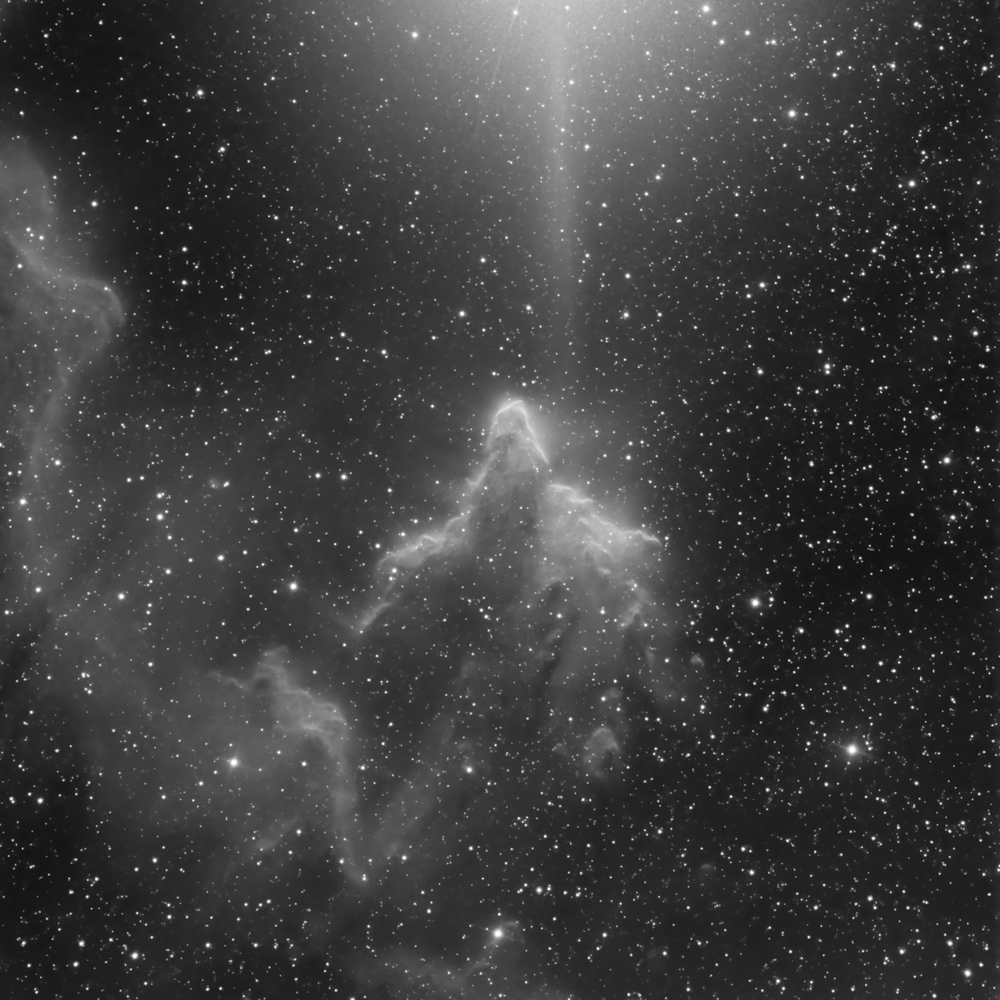
IC 63 is a combination
emission nebula and reflection nebula, visually located in the constellation Cassiopeia,
in the midst of a nice, dense star field, as seen from earth. Technical Information: (HaL)(HaR)(OIIG)(OIIIB): 630 (Ha):570 (OIII):636 (Lum):180(R):180(G):240(B) (a bit over 41 hours of total exposure time); Luminance layer is a blend of 32 fifteen-minute images through
the luminance filter, 52 three-minute images through the luminance filter, and 21 thirty-minute images through the Ha filter; Red channel is a blend of 12 fifteen-minute images through a red filter and the Ha data;
Green channel is a blend of 12 fifteen-minute images thorugh a green filter and 19 thirty-minute images through a OII filter; the Blue channel is a blend of 12 twenty-minute images through a blue filter and the
OIII data. All images were unbinned. I also took lots of SII data (in anticipation of doing a Hubble-palette version); the SII data were far more significant than I normally see, but I did not use it, since
the OIII data was almost non-existent, resulting in this predominately yellow image. Equipment: RC Optical Systems 14.5 inch Ritchey-Chrétien carbon fiber truss telescope, with ion-milled optics and RCOS field flattener, at about f/9, and an
SBIG STX-16803 with internal filter wheel (SBIG filter set), guided by an SBIG AO-X/STX Guider, all riding on a Bisque Paramount ME German Equatorial Mount. Image Acquisition/Camera Control: Maxim DL, controlled with ACP Expert/Scheduler, working in concert with TheSky X. Processing: All images calibrated (darks, bias and sky flats), aligned, and combined in Pixinsight. Color combine in Pixinsight. Some finish work (background neutralization, color
calibration, gradient removal, NoiseXTerminator and BlurXTerminator) done in Pixinsight; some finish work (Neat Image noise reduction, LRGB combination, contrast and saturation adjustment) was done in Photoshop CC. Location: Data acquired remotely from Sierra Remote Observatories, Auberry, California, USA. Date: Images taken on many nights during August and September of 2022. Image posted November 11, 2022. Date: Image scale of full-resolution image: 0.56 arcseconds per pixel. Seeing: Generally good
CCD Chip temperature: -25C Copyright 2022 Mark de Regt
The top of the image shows traces of the very bright (65,000 times as bright as our sun), very large (19 times the mass of our sun), very energetic (it emits 34,000 times the energy of our sun) Gamma Cassiopeia,
just off the frame. This remarkable star bathes the hydrogen gas of the nebula with ultraviolet light, causing the gas to emit the red color, and the bright blue of the star itself is reflected off the dust
(accounting, I think, for the more-than-expected pinkish color of that part of the nebula). The energy from the star eventually will result in the dissipation of the nebula.
This ghostly nebula is approximately 550 light years from us; the ghostlike part of the image is about 2 light years high. Using imagination, the ghost's head (with a very large beard) is looking toward
us (perhaps more evident in the Ha version).